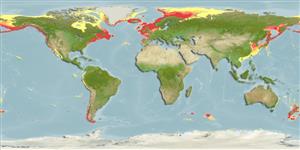Common names from other countries
Environment: milieu / climate zone / depth range / distribution range
Ecología
; rango de profundidad 0 - 534 m (Ref. 119523). Temperate; 85°N - 80°S, 180°W - 180°E
Northern Pacific, Northern Atlantic, Antarctic and the Arctic.
Length at first maturity / Tamaño / Peso / Age
Maturity: Lm ? range ? - ? cm Max length : 60.0 cm WD macho / no sexado; (Ref. 865)
Filters small suspended particles, which includes free bacteria and colloidal organic matter (Ref. 96471). Trophic level 1.7-2.3 (Ref. 96418). Part of the fouling communities attached to raft frames in mariculture zones (Ref. 127121).
Life cycle and mating behavior
Madurez | Reproducción | Puesta | Huevos | Fecundidad | Larva
Members of the class Demospongiae are hermaphroditic. Life cycle: The zygote develops into parenchymella larva (free-swimming) before settling down on a substrate where it grows into a young sponge.
Harms, J. 1993. (Ref. 2711)
IUCN Red List Status (Ref. 130435)
CITES status (Ref. 108899)
Not Evaluated
Not Evaluated
Human uses
| FishSource |
Herramientas
Más información
Age/Size
Crecimiento
Length-weight
Length-length
Morfología
Larva
Abundancia
Fuentes de Internet
Estimates based on models
Preferred temperature
(Ref.
115969): 2.1 - 25, mean 9.7 (based on 2098 cells).
Price category
Unknown.
